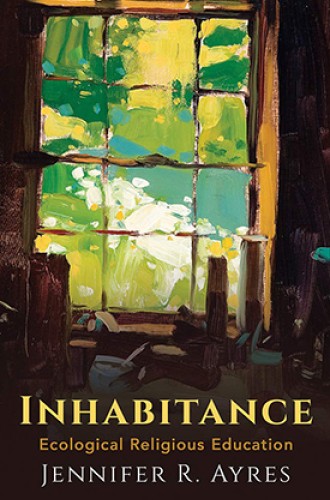A guide to religious education during the climate crisis
For Jennifer Ayres, it’s crucial to name our ecological identity and responsibility.
“Praise be to you, my Lord, through our Sister, Mother Earth, who sustains and governs us, and who produces various fruit with colored flowers and herbs.” So begins a canticle of St. Francis of Assisi, whose love for all creation anticipated contemporary environmentalism by a millennium.
The same words open the 2015 encyclical Laudato si’, one of Pope Francis’s first official papal statements. The encyclical in turn provides the epigraph for Jennifer Ayres’s guide to religious education in an era when Mother Earth’s children may be on the verge of committing matricide.
Ayres is a practical theologian who, in a time of accelerating climate change, seeks to counter both the despair of ecological activists and the complacency of those who profit from environmental exploitation. It is time for churches, she urges, to step forward with a compelling vision of a path that can deliver us from the prospects of environmental disasters that loom ever more imminent.
The key to living responsibly on an endangered planet, Ayres proposes, is to “become inhabitants.” This way of life entails fundamental changes in our practices, assumptions, attitudes, and emotions—beginning with the recognition that although God gave us the earth, it is not our property. Rather, we belong to the earth.
In the two creation stories of Genesis, Ayres observes, “an image of the human being as reigning powerfully over the earth is juxtaposed with an image of the human being as serving the earth.” We experience a “longing for home” that is best understood not as a desire to return to the garden but as an anticipation of the wholeness and richness that will attend the renewal of creation.
Inhabitance in the world, Ayres believes, is grounded in the cultivation of virtues—both traditional virtues (such as justice and courage) and “ecovirtues” (such as sustainability and resilience). These virtues are rooted in “the affective dimensions of ecological identity,” which include a sense of awe and wonder, a deep love and desire for creation, and a capacity for “grief, lamentation and repentance.”
The chapter in which Ayres expounds these themes is one of the richest in the book. To be a responsible inhabitant of the earth, she argues, we must begin by viewing the cosmos and the earth’s ecosystems with both joy (emulating St. Francis) and a sense of mystery. Then we must go beyond affirmation to embrace the world in love. As Pope Francis has written, becoming ecologically aware is like falling in love.
But loving something means recognizing how it is broken. There have always been signs of brokenness in creation, but now they are being compounded by our carelessness. This reality points to another affective dimension of inhabiting the earth: we must dwell in hope and seek to repair what we have broken.
Sustainability is the byword of many environmentalists, but Ayres finds it both too low and too lofty an ideal. While corporations claim to have embraced sustainability by making minor changes that amount only to window dressing, it’s becoming increasingly clear that sustainability as a global stance is no longer attainable. Ayres advocates replacing it with the virtue of resilience. This concept aligns with the consensus of climate scientists: only in our fantasies can we undo the damage we have done to the environment, yet there is a great deal we can do to help the living world adapt to new stresses and cope with changing environments.
How can we live in hope and pursue resilience? Ayres sketches an “embodied, affective, and reflective pedagogy” that will prepare us for inhabitance. The “fast knowledge” of science and technology must be balanced with the “slow knowledge” nurtured in reflective communities. Citing educational psychologist Benjamin Bloom and philosopher John Dewey, she calls for a holistic approach to learning, one that is attentive to local context. “The body, its sensory capacities, the emotions, and the mind work together in the cultivation of ecological consciousness through embodied experience.”
This ideal takes concrete shape in Ayres’s profiles of several church communities. A Presbyterian congregation in North Carolina that stands beside a polluted river has undertaken to restore its health by offering sermons and liturgies that celebrate the life-giving capacity of water, by organizing canoe trips, and by helping farmers control runoff. A community church in Wisconsin made up mostly of recent immigrants from the Global South has established an organic garden to produce food and offer experiential education.
A Washington, D.C., parish promotes “agrarian spirituality” by placing a pile of compost on the altar as a symbol of renewal and encouraging parishioners to plant flowers. A congregation of African Americans struggling with issues of poverty and poor health in North Carolina has found that both are less prevalent thanks to the establishment of an organic farm and beekeeping operation.
While Ayres’s local focus makes her vision tangible, it’s unfortunate that she doesn’t give much attention to national and international contexts. Small-scale initiatives can transform lives and build up communities, but the scale of the environmental crisis demands concerted action on the political level as well. Unless the nations that have brought the globe to the brink of catastrophe undertake profound economic changes—going well beyond the modest goal of recent international gatherings—we may find the practices of inhabitance unattainable on an uninhabitable earth. Ayres implies that concerted large-scale action is important, but she doesn’t say so directly.
Despite this lacuna, Inhabitance will be useful for the church. The local narratives that Ayres highlights make it clear that “ecological faith is incarnational,” a faith spoken equally through words and deeds. And becoming ecologically aware brings us “nearer to the creative, loving, and pulsing heart of God,” because “inhabitance is a path of sanctification.”





